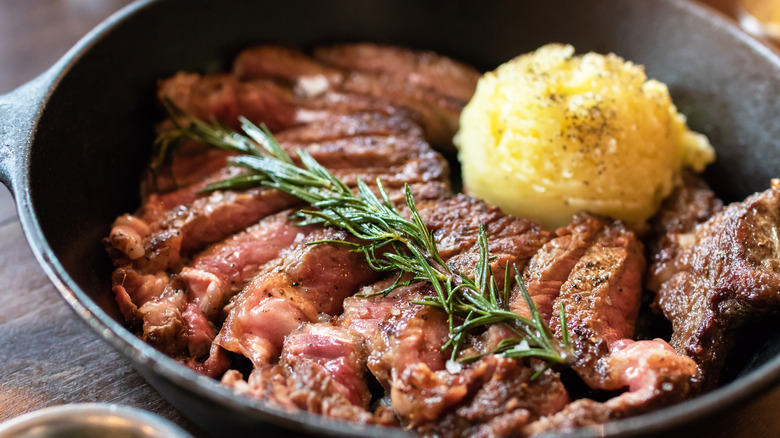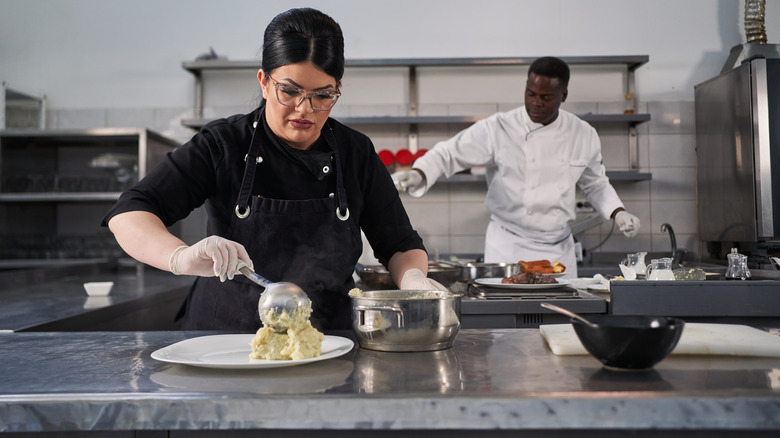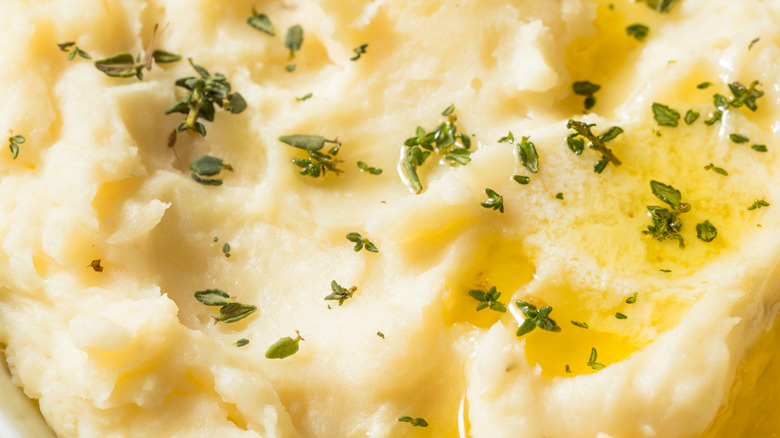The Simple Reason Steakhouse Mashed Potatoes Always Taste Better Than Homemade
If steakhouses offered bottomless mashed potatoes there's a good chance they'd have to change their name to potato houses. There's just something about those velvety smooth, luxuriantly creamy, full-flavored mashed potatoes that have most homemade versions beat beyond comparison. As it turns out, there is a pretty simple reason why steakhouse mashed potatoes are so much better than other versions: They don't skimp on the salt or fat.
Whereas most home cooks will use a pinch of butter, a couple of shakes of salt, and a bit of milk, steakhouse chefs aren't afraid to go all out with the dairy. There's no room for 2% or even whole milk in their mashed potatoes — the thinness of plain milk just isn't creamy enough to cut it. And creaminess is key! There's no going light on the seasoning either, not when it comes to whipping up mashed potatoes worthy of being served in a restaurant, at least.
Steakhouse mashed potatoes go heavy on the heavy cream
The ingredient list for most homemade mashed potatoes pales in comparison to what's used in steakhouses. Instead of regular milk, pro chefs generally use a generous helping of buttermilk and plenty of half-and-half or (even better) heavy cream in their potatoes. If you think the bartenders up front are pouring heavy, they've got nothing on the cooks in the back who are in charge of the mashed potatoes.
Butter is used just as liberally. This is super important for achieving that buttery texture steakhouse potatoes are known for, as well as imparting just the right flavor. Cream cheese is another common ingredient and there's a good reason why. Not only does it add its own share of salt, but cream cheese has a rich, decadent flavor that melts down and blends perfectly with the pureed potatoes, adding to that smooth, fluffy consistency that everyone craves.
Going easy on the salt leads to bland mashed potatoes and that's something that would never fly in a steakhouse. Salt is an important part of drawing out the potato flavor, after all. Without it, they just won't taste like what you expect when you sit down to a steak dinner. Garlic is also commonly used for seasoning — and the chefs don't go easy on it either.
Superb mashed potatoes are worth the effort
There's a good reason why steakhouses take their mashed potatoes so seriously. The side dish has to be able to hold its own next to a perfectly aged and heavily seasoned cut of beef. Otherwise, it's just a boring waste of space that you could get anywhere. And when you're forking over good money for a multi-course meal, the steakhouse's sides have to be just as good as the main dish (which is probably why a lot of steakhouses are stepping up their potato game — and their side dishes in general). For instance, at St. Anselm, a steakhouse in Brooklyn, New York, the mashed potatoes are pan-fried in lard for extra richness and a contrast of fluffiness and crispness.
Naturally, this same idea can be just as true at home as it is in a restaurant. So why not turn your mashed potatoes up a few notches next time? Doing so will elevate your entire meal, and the improvement will be well worth the cost for extra butter and cream. Once you get the hang of it there'll be no going back to the same bland potatoes that never had enough salt or dairy anyway.


